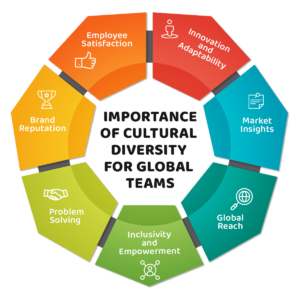Our world is more connected than ever before, thanks to advancements in technology, transportation, and globalization. Businesses now regularly employ teams comprised of individuals from various cultural backgrounds distributed across the globe.
While culturally diverse, global teams unlock innovation, creativity, and new perspectives, they also come with unique management challenges like communication breakdowns, different work styles, and a lack of unity. Successfully navigating issues stemming from cultural differences, geographic distances, and more requires a foolproof strategy.
And that’s what we’ll discuss today. We’ll talk about the importance of cultural diversity along with 6 proven ways to better manage it. Let’s get started!
Importance of Cultural Diversity for Global Teams

Racially and ethnically diverse companies are 35% more likely to outperform their competitors in terms of finances. Besides, enterprises with diverse management teams report greater innovation revenue. Here are the key benefits of building global teams for your organization.
- Innovation and Adaptability: Diverse perspectives spark creativity and drive innovative solutions. Cultural diversity equips teams to understand and adapt to international markets swiftly.
- Market Insights: A diverse workforce offers unique insights into local customs, languages, and consumer preferences, enabling businesses to tailor their strategies effectively.
- Inclusivity and Empowerment: Inclusive teams leverage the strengths of each member, fostering a culture of belonging and driving higher levels of engagement and productivity
- Global Reach: Reflecting the diversity of target markets, global teams can build trust, establish rapport, and deliver products and services that resonate with customers worldwide.
- Problem-Solving: Diverse teams approach challenges from varied angles, leading to comprehensive problem-solving and more robust decision-making processes.
- Employee Satisfaction: Inclusive environments where diversity is celebrated lead to higher employee morale, satisfaction, and retention rates.
- Brand Reputation: Embracing cultural diversity enhances brand perception, positioning businesses as inclusive and socially responsible entities.
How to Manage Cultural Diversity in Distributed Teams?
The key is facilitating open, bidirectional dialogue so all team members feel comfortable contributing ideas and airing concerns. This builds trust and cohesion even when working remotely.
Establish Clear Communication Channels and Encourage Open Dialogue
When working with global teams, it’s important to establish clear communication channels and guidelines early on. Effective communication brings together distributed teams comprised of members from different cultural backgrounds. This involves deciding on preferred platforms, cadences for meetings, language and terminology conventions, and protocols for providing feedback.
Here are some best practices to follow.
- Set regular virtual meetings where everyone can see each other to help build connections
- Create shared documentation where information is centralized
- Ensure the language used is clear and avoids idioms that may not translate across cultures
- Encourage team members to ask clarifying questions without judgment
- Actively listen and try to understand different perspectives and viewpoints
- Set norms for giving constructive feedback respectfully
The key is facilitating open, bidirectional dialogue so all team members feel comfortable contributing ideas and airing concerns. This builds trust and cohesion even when working remotely.
Cultivate Cultural Intelligence (CQ) and Practice Empathy
Lack of cross-cultural understanding can lead to severe communication breakdowns, misalignments, and conflicts that derail collaboration. By developing CQ, teams bridge gaps arising from cultural differences and varied perspectives.
Here are five tips to help you enhance cultural IQ and empathy.
- Educate yourself on teammates' cultures and norms
- Avoid assumptions based on cultural stereotypes.
- Adapt your behavior and language to make others comfortable
- Actively listen without judging the person.
- Consider situations from teammates’ cultural point of view
Foster a Culture of Inclusivity, Diversity, and Respect
Promoting inclusivity, embracing diversity, and maintaining respect should be central pillars when leading distributed teams. Ensure that policies, practices, and norms empower team members of all backgrounds to contribute fully.
Here’s how you can do it.
- Integrate cultural context and viewpoints in team discussions and decisions
- Call out and eliminate bias, discriminatory language, or behavior.
- Solicit input from introverts and those less likely to speak up.
- Recognize and appreciate multiculturalism as an asset and competitive advantage.
Establish Clear Protocols for Conflict Resolution
Having clear protocols for handling disagreements is crucial for maintaining team cohesion and productivity. Without established processes, conflicts can quickly escalate, lead to resentment between team members, and undermine trust.
Some best practices for managing conflict in distributed teams include:
- Establishing norms early on for giving constructive feedback and resolving disputes
- Using videoconferencing to discuss conflicts face-to-face when possible.
- Identifying a neutral third-party mediator that team members can turn to if they reach an impasse.
- Documenting agreements reached to resolve conflicts for future reference.
- Conducting post-mortems on disputes to understand what went wrong and prevent recurrence.
- Building in cool-off periods to let emotions dissipate before re-engaging.
Encourage Cross-Cultural Mentorship and Peer Learning
With distributed teams encompassing a diversity of cultures and perspectives, encouraging cross-cultural mentorship and learning opportunities is essential. When teammates actively share knowledge and guidance across cultural boundaries, it builds understanding, empathy, and unity. Moreover, peer learning breaks down barriers stemming from cultural misconceptions and lack of awareness.
Here’s how to facilitate fruitful cross-cultural collaboration.
- Match team members for one-on-one peer mentorships focusing on cultural/regional issues.
- Incorporate space for cultural topics into meetings for Q&A or mini-presentations.
- Rotate leading discussions on current events through diverse cultural lenses.
- Share examples of culture-related misunderstandings and how they were resolved.
- Request feedback from foreign teammates when crafting region-specific initiatives.
- Encourage casual virtual meetups for cultural exchanges around food, music, travel.
Using PEO Services for Enhanced Global Team Management
Given the complexities of managing a culturally diverse distributed workforce, many organizations are turning to Professional Employer Organizations (PEOs). PEO services assist global teams by streamlining onboarding across regions, providing localized training, enabling consistent company policies, and supplying in-region personnel support. They implement best practices for cross-border collaboration while respecting local norms.
Final Thoughts
Talent knows no boundaries! And if you want to hire globally and work with people across time zones, you need the right strategies to manage them. Begin with establishing clear communication channels and foster a culture of inclusion and respect. Furthermore, encourage cross-cultural mentorship and peer learning to build rapport within the organization.
Or you can work with a PEO service provider who can manage teams on your behalf. While not a complete substitute for in-house global management, partnering with an experienced PEO provides vital assistance. As borderless business becomes the norm, these services allow organizations to manage diversity more effectively and unite global teams.




















